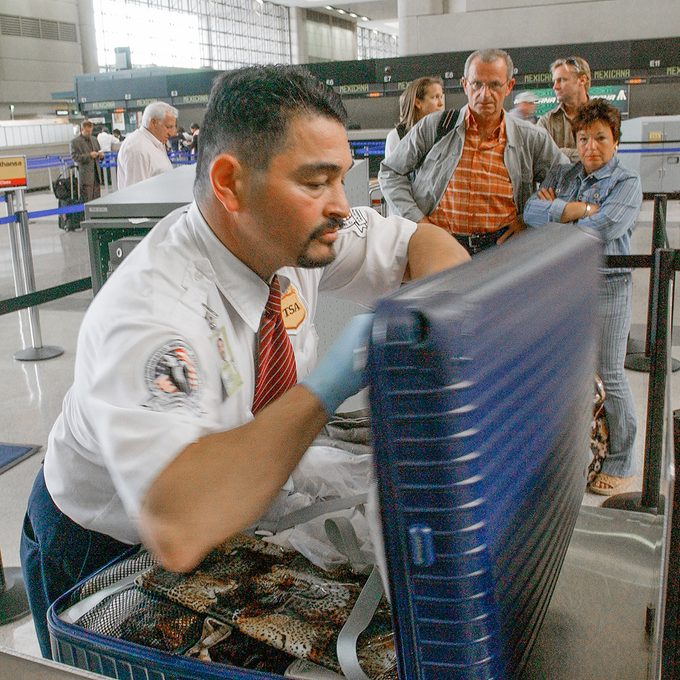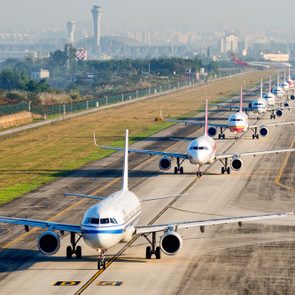Arrive at your destination with everything you've packed by keeping this FAA directive on a common gadget front of mind

This Common Gadget Is Banned in Checked Luggage—Here’s What You Need to Know

When packing for a flight, most seasoned travelers know what is and isn’t allowed in their checked-in luggage, though even the most experienced of us make the occasional mistake. For example, I recently tossed a tube of beloved suntan lotion into my carry-on last minute. The crushing sense of defeat I felt at security when I realized that the tube exceeded 3.4 ounces—the TSA limit for liquids—was all my fault.
But knowing what must be packed in a carry-on? That can be a different story. Now, a lesser-known rule regarding a common gadget, enacted years earlier and which some airlines, including Southwest, have recently tweaked and tightened, should be kept front of mind when planning your trip.
Read on to find out what item has to go on the plane with you instead of being stowed away.
Get Reader’s Digest’s Read Up newsletter for more news, travel, tech, cleaning, humor and fun facts all week long.
Which item is banned from flights?

According to the Federal Aviation Administration (FAA), spare lithium-ion and lithium-metal batteries, rechargeable batteries used in common gadgets such as power banks and portable cellphone chargers, are banned from checked luggage and must be packed in carry-on bags only.
The reason? They’re fire hazards. Lithium-ion batteries “store a lot of energy in a small footprint,” explains Brian O’Connor, senior engineer at the National Fire Protection Association (NFPA).
While that’s great when you’re looking to recharge your device on the go, he says, they carry the risk of overheating via a chain-reaction process called “thermal runaway.” This occurs when the battery short-circuits, turning its components into flammable and toxic gases, causing smoke and/or fire.
Thermal runaway can be caused by various factors, including damage, overheating, exposure to water, overcharging, manufacturing defects or improperly packing the battery. (The FAA recommends covering battery terminals with tape or using a battery case when packing a battery.)
While lithium-metal batteries—such as those used in single-use, non-chargeable batteries—are not as risky, they can also catch fire due to thermal runaway.
How big of a problem has this been?
While these types of airplane fires are rare, the number of fires caused by batteries has been increasing. In 2024, 89 incidents of overheating lithium batteries on planes were recorded by the FAA, compared to just 50 incidents in 2018.
Domestically, a growing number of airlines reported incidents in 2024, including a fire sparked by a cellphone battery in a Southwest Airlines plane at the Denver International Airport. A Spirit Airlines flight was also diverted after what was believed to be a passenger’s battery, stored in an overhead bin, catching fire.
The mostly widely reported incident, however, occurred in January 2025, when a spare power bank stored in an overhead bin was cited as the likely source of a fire in a South Korean Air Busan plane. The plane was destroyed, though luckily all passengers and crew were evacuated safely. The incident, however, meant a big change in the rule for many Asia-based airlines.
How are restrictions changing now?
As a result of the Air Busan fire, all South Korean airlines, some Taiwanese airlines and Malaysia Airlines have banned lithium batteries even from carry-on baggage stashed in overhead bins. Instead, they must be kept within a passenger’s arm’s reach and in sight when in use. This past week, Southwest Airlines became the first U.S. carrier to introduce a similar policy.
Additionally, Cathay Pacific, Singapore Airlines, Thai Airways, South Korean Airlines, Busan Air and other Asia-based airlines have prohibited power banks from being used during flights or being charged using onboard USB ports.
Are there other lithium-battery restrictions?
Yes. Because these batteries are ubiquitous—in addition to your spare batteries, you’ll find them in personal electronics such as cameras, laptop computers, tablets, watches, e-cigarettes and vaping pens, and more—there are few other things to keep in mind.
- All electronic devices powered by such batteries must be completely powered off, and not simply put in sleep or hibernation mode, when packed in checked or carry-on luggage.
- Lithium batteries must be under 2 grams of lithium per battery, and lithium-ion batteries are limited to a max rating of 100 watt hours (Wh) per battery. These limits allow for nearly all types of lithium batteries used by the average person in their laptops, phones and other electronic devices. There are size exceptions for medical devices, so check the FAA “Pack Safe” guide for official size limits or with your airline.
- Most domestic carriers allow you to carry up to two spare larger lithium-ion batteries (101–160 Wh) or lithium metal batteries (2–8 grams). This size covers the larger after-market extended-life laptop computer batteries and some larger batteries used in professional audio/visual equipment. Batteries carried for sale or distribution—such as vendor samples, for example—are prohibited.
- Most airlines require that spare batteries are stored in a plastic bag or kept in their original retail packaging.
Do the rules vary by airline?
While the ban of lithium batteries in checked luggage is in place for all airlines that conduct flights into or over U.S. airspace, some rules, such as size and quantity, are airline-dependent. For example, American Airlines and United Airlines allow up to two spare batteries for personal use, while Delta allows up to 20.
What will happen if you have a charger in your checked bag?
Should your carry-on bag need to be checked at the gate or at plane side, all spare lithium batteries and power banks must be removed from the bag and kept with you in the aircraft cabin.
If you try to sneak one in or you forgot about it, know that any lithium batteries found in checked bags might not make it back to you. There are no provisions for returning prohibited items removed from checked baggage, according to the TSA.
RELATED:
- New Study: If You Fly Out of This Airport, Be Prepared to Wait Around 50 Extra Minutes Before Takeoff
- You’re Spending a Lot More at the Airport Than You Think—Here’s How Much
- The New Gen Z Travel Trend You Won’t Want to See at the Airport
About the expert
|
Why trust us
Reader’s Digest has published hundreds of travel stories that help readers explore the world safely, easily and affordably. We regularly cover topics such as the best places to visit (and the best times to visit them), tips and tricks to zoom through airport security, flight-attendant secrets, hotel-room hacks and more. We’re committed to producing high-quality content by writers with expertise and experience in their field in consultation with relevant, qualified experts. We rely on reputable primary sources, including government and professional organizations and academic institutions as well as our writers’ personal experiences where appropriate. We verify all facts and data, back them with credible sourcing and revisit them over time to ensure they remain accurate and up to date. Read more about our team, our contributors and our editorial policies.
Sources:
- Brian O’Connor, senior engineer at the National Fire Protection Agency (NFPA); interviewed, May 2025
- FAA: “Pack Safe Lithium Batteries”
- FAA: “Lithium Battery FAQ”
- FAA: “Lithium Battery incidents”
- New York Times: “Rules for Portable Batteries on Planes Are Changing. Here’s What to Know”



